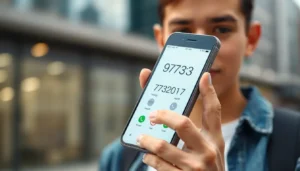Table of Contents
ToggleIn an unpredictable world, personal safety devices have become essential tools for enhancing individual security. From pepper sprays to personal alarms, these gadgets empower people to take control of their safety wherever they go. With rising concerns about personal safety, understanding the various options available is crucial for making informed choices.
As technology evolves, so do the features and functionalities of these devices. Many modern personal safety tools integrate smart technology, offering users innovative solutions that can easily fit into their daily lives. Whether someone is commuting, traveling, or simply enjoying outdoor activities, having the right personal safety device can provide peace of mind and a sense of security.
Overview of Personal Safety Devices
Personal safety devices enhance individual security in various environments. Many types of devices exist, each designed to address specific safety concerns.
1. Pepper Spray
Pepper spray contains a combination of capsaicin and other ingredients. It’s effective for self-defense, temporarily incapacitating an attacker. Many brands offer compact models, enhancing portability.
2. Personal Alarms
Personal alarms emit a loud sound when activated. They draw attention, potentially deterring threats and attracting help. Users find compact and lightweight options, making them easy to carry.
3. Personal GPS Trackers
Personal GPS trackers provide real-time location data. Families can monitor loved ones’ whereabouts and ensure safety during outings. Models vary, from discreet wearables to smartphone-integrated applications.
4. Smart Home Security Devices
Smart home security devices include cameras, doorbell cameras, and motion sensors. These devices enhance security by allowing remote monitoring. Connected apps send alerts to users, keeping them informed.
5. Wearable Safety Devices
Wearable safety devices come in forms like bracelets or pendants. They often feature emergency buttons, sending alerts to contacts quickly. Some devices also offer built-in GPS capabilities.
6. Flashlights with Built-in Safety Features
Flashlights equipped with strobe functions can disorient potential threats. Some models also include self-defense tools, such as sharp edges. These dual-purpose devices serve practical functions while enhancing safety.
The evolution of personal safety devices reflects advancements in technology. Increased connectivity, user customization, and integration into daily life provide users with greater peace of mind.
Types of Personal Safety Devices

Numerous personal safety devices exist to enhance individual security. Below are key categories that address various safety concerns.
Alarms and Sirens
Alarms and sirens serve as vital personal safety devices, designed to deter potential threats and attract attention during emergencies. Many devices incorporate features such as loud sounds, flashing lights, or both, which help to notify bystanders of distress. Examples include personal alarms that fit on keychains and emergency sirens capable of emitting sounds up to 130 decibels. These devices are compact, making them easy to carry and access quickly in critical situations.
Personal GPS Trackers
Personal GPS trackers offer real-time location monitoring, providing users and their families peace of mind during outdoor activities or travel. These trackers come equipped with features like SOS buttons, geofencing alerts, and mobile app connectivity, enabling individuals to quickly notify emergency contacts. Some models allow for two-way communication, enhancing safety in case of emergencies. High-quality trackers maintain battery life for extended periods, ensuring constant accessibility when it’s most needed.
Pepper Sprays and Self-Defense Weapons
Pepper sprays and other self-defense weapons deliver reliable protection against potential aggressors. Pepper sprays contain oleoresin capsicum, which causes temporary blindness and pain, giving the user time to escape. Various models provide different spray ranges and quantities, catering to personal preferences for concealment and ease of use. Other self-defense tools include stun guns and tactical knives, designed for quick deployment in threatening situations. Proper training in the use of these devices enhances their effectiveness, empowering individuals to defend themselves confidently.
Features to Consider
When selecting a personal safety device, several key features enhance user experience and effectiveness. Evaluating these factors ensures the device meets individual safety needs and preferences.
Battery Life and Ease of Use
Battery life directly impacts the reliability of a personal safety device. Long-lasting batteries reduce the frequency of recharging or replacement, ensuring consistent performance during emergencies. Additionally, ease of use simplifies operation under stress. Devices with intuitive interfaces and quick-access features enable fast response in critical situations.
Size and Portability
Size and portability determine how easily users can carry personal safety devices. Compact and lightweight designs enhance accessibility, allowing individuals to keep devices on hand at all times. Portability is particularly crucial for devices like personal alarms or pepper sprays, which need to be readily available in various environments, from urban settings to outdoor excursions.
Cost and Value
Cost and value play a significant role in the decision-making process. While some personal safety devices come with a higher price tag due to advanced features, it’s essential to assess their overall value. Investing in durable, reliable devices with proven effectiveness can offer greater protection over time. Comparing costs against functionality ensures that users receive the best safety solutions within their budgets.
Effectiveness of Personal Safety Devices
Personal safety devices prove effective in enhancing individual security, often empowering users in various situations. Their success stems from real-life applications and awareness of limitations.
Real-Life Success Stories
Numerous accounts illustrate the effectiveness of personal safety devices.
- Pepper Spray Incidents: A college student effectively deterred an attacker with pepper spray, enabling her to escape unharmed.
- Personal Alarm Alerts: A night jogger activated a personal alarm, attracting immediate assistance from nearby pedestrians and averting a potential assault.
- GPS Tracker Recovery: A parent successfully located their lost child using a personal GPS tracker, highlighting the importance of real-time monitoring.
These examples show that when used properly, personal safety devices offer tangible safety benefits and contribute to an increased sense of security.
Limitations and Considerations
While personal safety devices provide various advantages, understanding their limitations is crucial.
- Response Time Issues: Devices rely on immediate user action, which can delay response in times of panic.
- False Sense of Security: Users may underestimate other safety measures, believing that devices alone guarantee protection.
- Environment Suitability: Some devices perform better in specific environments than others, limiting their effectiveness in diverse situations.
- Legal Restrictions: Local laws may regulate the use of self-defense tools like pepper spray, requiring awareness of legal implications.
Highlighting these factors fosters informed decision-making, ensuring individuals select appropriate safety devices tailored to their unique circumstances.
Personal safety devices are essential tools for enhancing security in an unpredictable world. With a variety of options available individuals can choose devices that best suit their needs and lifestyles. The integration of modern technology has made these devices more effective and user-friendly ensuring they fit seamlessly into daily routines.
Investing in reliable personal safety devices not only provides peace of mind but also empowers individuals to take control of their safety. By carefully considering features like portability and functionality users can select the right devices to protect themselves in various situations. Ultimately being proactive about personal safety can lead to a more confident and secure lifestyle.







